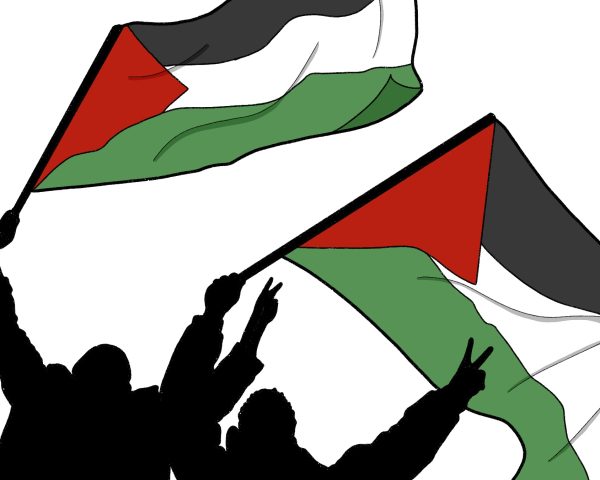
2.1 million people live in the Gaza Strip. The Palestinian death toll has surpassed 41,000. Charlie Trumbull | Washtenaw Voice
Lily Cole and Charlie Trumbull
The Washtenaw Voice
Palestinian WCC students, many with family in the region, experience fear, loss and societal pressures.
Over the last year, the Gaza Strip has seen bombardment and destruction, with at least 41,788 Palestinians killed.
On October 7, 2023, Hamas, the Palestinian faction that governs the Gaza Strip, launched coordinated armed attacks from the Gaza Strip into southern Israel.
1,200 men, women and children, including 46 Americans and others from more than 30 countries, were killed by Hamas. 254 people were taken hostage, the U.S. Department of State reports.
As of Oct. 3 of this year, 1,139 Israelis have been killed, according to Al-Jazeera.
Al-Jazeera reports that every hour in Gaza, 15 people are killed. Six are children. 85% of schools are damaged. The news organization also reports that more than half the homes in Gaza have been damaged or destroyed, 65% of roads were damaged and 17 out of 36 hospitals are partially functional.
One year later, people, including WCC students, are still navigating the grief as the war continues.
Student stories
WTMC student Leen Shalabi visited Jerusalem for the first time at 17-years-old.
She explained what life looks like in Gaza today, saying, “The West Bank is like a prison, and each city is like a cell.” She described the fencing around cities as making it almost impossible to move through Gaza in daily life.
Shalabi has dual citizenship in the U.S. and Palestine. Her extended family still lives in war-torn Gaza. She recounted a story of one of her relative’s hometown being ransacked by Israeli settlers who “set cars and houses on fire.”
One of Shalabi’s family member’s houses was intentionally burned. “It feels like a part of [me] has been burnt.”
2.1 million people live in the Gaza Strip, a piece of land on the border of the Mediterranean Sea, controlled by Israel and Egypt. More than 170,000 people in the United States identified as having Palestinian heritage in the 2020 census.
Lamees Hamamy, a WTMC student, said she always felt some connection to what was happening but never really felt it until Oct. 7, when she felt old enough to understand.
“I always felt a sense of security because my family is from Nablus and Ramallah, which isn’t targeted as much as Gaza,” she said. “I later found out that we have family in Gaza. 26 of them had been killed… That’s when I realized it was real. It’s not just some other realm.”
“There were tears after tears,” Hamamy explained. “I’m seeing images that are coming out [of Gaza] at such a young age. I’m imagining what it’s like being there for the kids, for anybody, and I think that’s when it starts to take a toll on me.”
Shalabi shared what her days feel like in Ann Arbor compared to those of her family abroad.
“Every day is filled with mystery,” Shalabi said. “It’s painful to go to sleep not knowing if the next morning [could] bring that call. That one of your family members has been hit by an airstrike.”
Recently, she asked a relative if she had ever considered immigrating to America. Her relative said, “If my neighbor died from a missile, I must die with her.”
Shalabi explains that Palestinians feel deeply connected to one another in the face of conflict. “If they leave, they lose,” Shalabi said. “They’re losing their cattle to their oppressors, and the oppressors get what they want.”
“This is not a Jewish versus Muslim war,” Shalabi said. “Palestinian Christians, Palestinian Jews, Palestinian Atheists, Palestinian Muslims, and LGBTQ members of Palestine. They’re all in this together.”
Hamamy talked about her sister, who she wishes she could be like, and how she’s president of one of the pro-Palestinian groups on the University of Michigan’s campus and led an encampment. The family’s garage is becoming a “whole storage unit for her protesting items.”
“She was able to take the initiative more than me,” Hamamy said. “There’s only so much I can do, not having a license and still being in high school. There’s only so much I can do at that point.”
Hamamy said her support from friends and family never wavers and ensures she has “a good environment.”
“I’m very close with all my friends,” she said. “Everybody understands what’s going on. Nobody turns a blind eye to it. I feel security in that.”
Nemeh Nimera, an undecided WTMC student, says many societal pressures exist. “[The war] socially affects [Arabs]. Even if you’re not from Palestine.”
Last year, Nimera attended protests at the Israeli Embassy in Washington, D.C., with tens of thousands of Palestine supporters gathering to demand a ceasefire. Here, she reports seeing counter protesters get into physical altercations. “I’ve [seen] people try to knock down flags and tents. Some people got arrested.”
As a high school student, people denounce what Nimera has to say simply because she’s young.
“Age doesn’t matter,” Nimera stated. “Someone who’s 15 can be more educated than a 50-year-old about a certain topic. Everyone has different perspectives of things and different levels of knowledge.”
Shalabi emphasized that her identity is a big part of who she is.
“I will forever be proud to be Palestinian,” she said. “I look home and see the people I descended from. [I] see the people out there fighting and how they won’t let anyone take anything away from them–[it’s] probably the biggest compliment ever.”
Editor’s note: An earlier version of this story failed to include information about the October 2023 Hamas attack that led to Israel’s assault on Gaza. The story has been updated to include that information.

